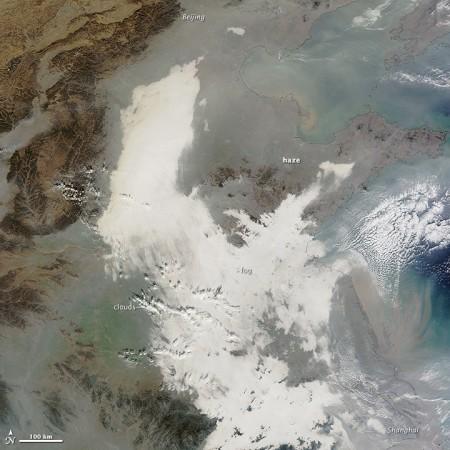Despite a million premature deaths and damage to the health of hundreds of children and adults, the Republic of China has failed to implement an effective policy to control the hazardous rise in air pollution levels.
A study commissioned by the Greenpeace has found that the hazardous levels of air pollution are off-charts. The study traced that the airbone chemicals from burning of coal had killed about 260,000 people in 2011. It also found that the pollutants led 3,20,000 children and 61,000 adults to suffer from asthma and about 36,000 babies being born with low weight.
China's air pollution problems frequently makes headlines all over the world. Despite all efforts throughout the year, China's nitric oxide emission has only risen through 2011 and 2012. The situation even now remains alarming.
Recently, the National Aeronautics and Space Administration (NASA) also released a disturbing image.

The statement from NASA observatory noted: "China suffered another severe bout of air pollution in December 2013. When the Moderate Resolution Imaging Spectroradiometer (MODIS) on NASA's Terra satellite acquired this image on December 7, 2013, thick haze stretched from Beijing to Shanghai, a distance of about 1,200 kilometers (750 miles). For comparison, that is about the distance between Boston, Massachusetts, and Raleigh, North Carolina. The brightest areas are clouds or fog. Polluted air appears gray. While northeastern China often faces outbreaks of extreme smog, it is less common for pollution to spread so far south."
Rudolf Husar, director of the Center for Air Pollution Impact and Trend Analysis at Washington University, explained: "The fog has a smooth surface on the top, which distinguishes it from mid- and high-level clouds that are more textured and have distinct shadows on their edge. If there is a significant haze layer on top of the fog, it appears brownish. In this case, most of the fog over eastern China is free of elevated haze, and most of the pollution is trapped in the shallow winter boundary layer of a few hundred meters."
On the day this natural-colour image was acquired by Terra, ground-based sensors at the US embassies in Beijing and Shanghai reported PM2.5 measurements as high as 480 and 355 micrograms per cubic meter of air respectively. The World Health Organization considers PM2.5 levels to be safe, when they are below 25.
It further observed that the air quality index (AQI) reached 487 in Beijing and 404 in Shanghai. An AQI above 300 is considered hazardous to all humans, not just those with heart or lung ailments.
Alarmed by the rise in the pollution levels, the Chinese authorities have announced that they may clamp down on the use of fireworks for the Lunar New Year. The pollution situation in China is alarming, and it would require radical measures to bring it to control.

















